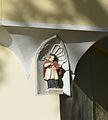Yard at home
The Hof zu Hausen bei Eisenbach is a manorial estate from the 13th century. The facility is a listed building .
history
The Hof zu Hausen was built as a branch of the Gnadenthal monastery at the latest in the 13th century . In 1275 the monastery acquired the farm from the von Velden family. The previous owner is said to have been a knight Hartrad von Merenberg .
After the Thirty Years War it was converted into a women's monastery, but soon fell to the Nassau-Diez family . 1659 is the court as of Nassau-dietzer special loans to Achatius of Hohenfeld been awarded. Since then, the von Hohenfeld family, who owned this fiefdom, provided the Trier Camberger Oberamtmen, whereby the farm was in fact part of the Camberg office . The office of Camberg was dichotomous . The rulers were Kurtrier and Nassau. Nassau did not recognize the affiliation to the Camberg Office, but considered the Hof zu Hausen to be an exclave of the Dauborn Office . At times the homestead expanded into a small settlement called " Frondorf ", which existed from at least the late 12th to the late 14th century and then fell into desolation.
In 1771 the conflict between Kurtrier and Nassau broke out openly. The manager of the court, Philipp Kratz, died on April 28, 1771 and Kurtrier and Nassau-Orange were fighting over the right to regulate the inheritance.
The oranische bailiff Ernst Cornelius Pagenstecher ended the conflict of competence on 26 October 1771 by riding out with 12 armed men and had to bring the controversial legacy in the (undisputed oranische) Gnadenthal.
However, this fait accompli did not create a clear picture. The next conflict arose in the following year. On June 13, 1772 there was a fight in the yard. The farmer Wolf refused to obey a summons to Camberg. The Elector of Trier then had his cattle seized. Ernst Cornelius Pagenstecher then arranged for Nassau soldiers to be transferred to the court in order to protect his sovereign rights.
Kurtrier responded with concentrated military power. After a short time, 7,000 soldiers faced each other on both sides. It was possible to avoid the military conflict and to conclude a ceasefire. The Lower Elder Convention of July 1, 1772 ended the conflict with a compromise.
From 1822 the farm was owned by Major General August von Kruse from Nassau . He received it in recognition of his services in the Wars of Liberation. On the 58 hectare property, he tried new cultivation methods and made cattle breeding experiments. His findings were reflected in specialist publications.
The model farm became a domain property and housed, among other things, the official residence of the local forester. The property has been private property since 1918. In 1928 the Wiesbaden pharmacist Adam Herbert acquired farms and lands. Today the farm belongs to the Plettenberg family . Friedrich August Graf von Plettenberg has been the owner since 2003.
In 2000 and 2001 he had the estate renovated from the ground up in the proper style. The courtyard, with its six apartments and the chapel on the edge of the forest, with the grave of August Freiherr von Kruse, is now a listed building.
Every year on Ascension Day there is a procession of the Catholic parish in Eisenbach.
Building description
court
The main building of the courtyard is the two-story, elongated mansion with a high hipped mansard roof . It was built in 1662 by Achatius von Hohenfeld and later plastered. The coat of arms of Achatius von Hohenfeld is located above the archway. The baroque niche figure of Saint Nepomuk is located under a transverse bay window at the front corner . The cast iron balcony comes from Nassau production around 1840.
The servants' quarters adjoin the main house at right angles. The farm now has a total of six apartments. In the courtyard there is a large slated barn from the end of the 19th century. In 1972 the large barn on the slope was demolished.
The courtyard wall and garden terrace with classical stone vases date from the time of Kruses. In front of the manor there is a fenced-in tree park and an avenue over the Bachaue.
Burial chapel
About 250 meters to the east, at an old crossroads, is the burial chapel of August Freiherr von Kruse († 1848) and his wife Henriette, née von Dungern († 1873). The small memorial chapel in Romanesque arched style with gable and wall aedicules consists of a small prayer room and the mortuary chamber with the coffins on the back of the building. The walls show imitation square joints on smooth stone .
Web links
- State Office for Monument Preservation Hessen (Ed.): Complete system Hof zu Hausen In: DenkXweb, online edition of cultural monuments in Hessen
- Side of the estate
- Frondorf. Historical local dictionary for Hessen. In: Landesgeschichtliches Informationssystem Hessen (LAGIS).
literature
- Josef Hörle: History of the Hof zu Hausen . Wiesbaden 1922.
- Frank Zabel: History of the Hof zu Hausen . Niederselters 2006.
- Ulrich Lange: EC Pagenstecher - his family and the end of both offices. Camberger Verlag, 1988, ISBN 3-87460-064-5 , p. 21 ff.
Coordinates: 50 ° 20 ′ 15.2 ″ N , 8 ° 16 ′ 45.1 ″ E


